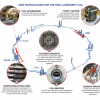After a record-breaking summer, the Large Hadron Collider is preparing for a major upgrade.
Following a two-year hiatus, the Large Hadron Collider (LHC) finally approached its maximum operating potential this summer, but the international team of physicists behind the project think they can do better.
The LHC, which was built by the European Organization for Nuclear Research (CERN), was originally designed to accelerate protons to nearly the speed of light, in small bunches with short breaks in between. Every time two protons collide at these high speeds, a Higgs Boson is created, so when there are more protons in a bunch or shorter spacing between bunches, more Higgs Bosons will be created. The size of each proton bunch is proportional to the beam’s “luminosity,” which is measured in teraelectronvolts (Tev), while the spacing is measured in nanoseconds (ns).
SEE ALSO: LHC’s “Cosmic Piano” Plays the Music of the Universe
In 2012, the massive machine generated 4 TeV of energy, but two months after rebooting in June, the LHC reached 13 TeV for the first time. And this was just a technical run. Ultimately, physicists want to reach 14 TeV, which will allow them to produce to 15 million Higgs bosons per year, more than 10 times the number produced in 2011 and 2012.
This week (October 29, 2015) physicists and engineers met at CERN to discuss the upgrade that will make the new energy limit possible. For the past four years, they have been drawing up designs for the new High-Luminosity Large Hadron Collider (HL-LHC), which will be fully operational by 2015. These designs include some revolutionary new technologies.
“We have to innovate in many fields, developing cutting-edge technologies for magnets, the optics of the accelerator, superconducting radiofrequency cavities, and superconducting links,” explained Lucio Rossi, Head of the High-Luminosity LHC project.
The new equipment will replace about 1.2 kilometers of the 27 kilometer long tunnel and help to increase the likelihood of proton collision. Now that the designs have been completed, engineers will develop prototypes with construction expected to begin in 2018.
Even though it hasn’t reached its full potential, the LHC has already led to the discovery of the Higgs boson and the pentaquark, two particles that were only theoretical until the LHC came along. We can only imagine what new mysteries will be revealed when it reaches full speed.
Based on materials provided by CERN.









Facebook comments